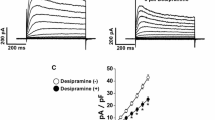Summary
The resting membrane potential of smooth muscle cells of the rabbit portal vein was −51.2 mV. LP-805 (8-tert-butyl-6,7-dihydropyrrolo[3,2-e] 5-methylpyrazolo [1,5-a] pyrimidine-3-carbonitrile) hyperpolarized the membrane to −62.3 mV (10 μM) and inhibited the burst spike discharges as measured using the microelectrode method. In dispersed smooth muscle cells, LP-805 (10 μM) generated an outward-current with a maximum amplitude of 68 pA at a holding potential of −40 mV in experiments using the voltage-clamp procedure. The reversal potential of the outward current evoked by LP-805 was −82 mV and this value was close to the equilibrium potential for K+ (−80 mV) in the present ionic conditions, suggesting that LP-805 activated the K+ channel. Generation of both the hyperpolarization and the outward c urrent by LP-805 was inhibited by glibenclamide (≥ 1 μM). Using the cell-attached and cell-free patch-clamp (in the presence of GDP) procedures, the maxi-K+ channel current (150 pS) could be recorded in the absence of LP-805; application of LP-805 additionally opened a small conductance K+ channel current (15 pS) without change in the activity of the maxi-K+ channel. The maxi-K+ channel was sensitive to charybdotoxin (0.1 μM) and to intracellular Ca2+ ([Ca2+]i) concentration. The 15 pS channel was insensitive to [Ca2+]i and charybdotoxin, but sensitive to intracellular ATP concentration. Glibenclamide (> 1 μM) inhibited the 15 pS K+ channel activated by LP-805. These actions of LP-805 on the maxi-K+ and 15 pS K+ channels are the same as those previously observed for nicorandil and pinacidil. Thus, LP-805 is a K+ channel opener with a chemical structure different from those of the known openers.
Similar content being viewed by others
References
Beech DJ, Bolton TB (1989) Properties of the cromakalim-induced potassium conductance in smooth muscle cells isolated from the rabbit portal vein. Br J Pharmacol 98:851–864
Benham CD, Bolton TB (1986) Spontaneous transient outward currents in single visceral and vascular smooth muscle cells of the rabbit. J Physiol 381:385–406
Carl A, Brwen S, Gelband CH, Sanders KM, Hume JR (1992) Cromakalim and lemakalim activate Ca2+-dependent K+ channels in canine colon. Pflügers Arch 421:67–76
Cook NS (1988) The pharmacology of potassium channels and their therapeutic potential. Trends Pharmacol Sci 9:21–28
Cook NS, Quast U (1990) Potassium channel pharmacology. In: Cook NS (ed) Potassium channels-structure, classification, function and therapeutic potential. Ellis Harwood, Chichester, pp 181–255
Edwards G, Weston AH (1990) Structure-activity relationships of K+ channel openers. Trends Pharmacol Sci 11:417–422
Eltze M (1989) Glibenclamide is a competitive antagonist of cromakalim, pinacidil and RP 49356 in guinea-pig pulmonary artery. Eur J Pharmacol 165:231–239
Gelband CH, Lodge NJ, van Breemen C (1989) A Ca2+-activated K+ channel from rabbit aorta: modulation by cromakalim. Eur J Pharmacol 167:201–210
Hermsmeyer K (1988) Ion channel effects of pinacidil in vascular muscle. Drugs 36 [Suppl 7]:29–32
Inoue I, Nakaya Y, Nakaya S, Mori H (1989) Extracellular Ca2+-activated K channel in coronary artery smooth muscle cells and its role in vasodilation. FEBS Lett 255:281–284
Inoue I, Nakaya S, Nakaya Y (1990) An ATP-sensitive K+ channel activated by extracellular Ca2+ and Mg2+ in primary cultured arterial smooth muscle cells. J Physiol 430:132
Inoue R, Kitamura K, Kuriyama H (1985) Two Ca-dependent K channels classified by application of tetraethylammonium distribute to smooth muscle membrane of the rabbit portal vein. Pflügers Arch 405:173–179
Kajioka S, Oike M, Kitamura K (1990) Nicorandil opens a calcium-dependent potassium channel in smooth muscle cells of the rat portal vein. J Pharmacol Exp Ther 254:905–913
Kajioka S, Kitamura K, Kuriyama H (1991) Guanosine diphosphate activates an adenosine 5′-diphosphate-sensitive K+ channel in the rabbit portal vein. J Physiol 444:397–418
Kajioka S, Nakashima M, Kitamura K, Kuriyama H (1991) Mechanisms of vasodilation induced by potassium-channel activators. Clin Sci 81:129–139
Kishii K, Morimoto T, Nakajima N, Tsujitani M, Takayanagi I (1992a) Endothelium-dependent vasodilation by LP-805, a novel vasodilating agent, on rat thoracic aorta. Gen Pharmac 23:343–346
Kishii K, Morimoto T, Nakajima N, Yamazaki K, Tsujitani M, Takayanagi I (1992b) Effects of LP-805, a novel vasorelaxant agent, a potassium channel opener, on rat thoracic aorta. Gen Pharmac 23:347–353
Leblanc N, Wilde DW, Keef KD, Hume JR (1989) Electrophysiological mechanisms of minoxidil sulfate-induced vasodilation of rabbit portal vein. Circ Res 65:1102–1111
Nakao K, Okabe K, Kitamura K, Kuriyama H, Weston AH (1988) Characteristics of cromakalim-induced relaxations in the smooth muscle cells of guinea-pig mesenteric artery and vein. Br J Pharmacol 95:795–804
Nakashima M, Akata T, Kuriyama H (1992) Effects on the rabbit coronary artery of LP-805, a new type of releaser of endothelium-derived relaxing factor and a K+ channel opener. Circ Res 71:859–869
Ohya Y, Kitamura K, Kuriyama H (1987) Cellular calcium regulates outward currents in rabbit intestinal smooth muscle cell. Am J Physiol 252:C401–410
Ohya Y, Terada K, Yamaguchi K, Inoue R, Okabe K, Kitamura K, Hirata M, Kuriyama H (1988) Effects of inositol phosphates on the membrane activity of smooth muscle cells of the rabbit portal vein. Pflügers Arch 412:382–389
Raeburn D, Brown TJ (1991) RP 49356 and cromakalim relax airway smooth muscle in vitro by opening a sulphonylurea-sensitive K+ channel: A comparison with nifedipine. J Pharmacol Exp Ther 256:480–485
Standen NB, Quayle JM, Davies NW, Brayden JE, Huang Y, Nelson MT (1989) Hyperpolarizing vasodilators activate ATP-sensitive K+ channels in arterial smooth muscle. Science 245:177–180
Winquist RJ, Heaney LA, Wallace AA, Baskin EP, Stein RB, Garcia ML, Kaczorowski GJ (1988) Glyburide blocks the relaxation response to BRL 34915 (cromakalim), minoxidil sulfate and diazoxide in vascular smooth muscle. J Pharmacol Exp Ther 248:149–156
Xiong Z, Kajioka S, Sakai T, Kitamura K, Kuriyama H (1991) Pinacidil inhibits the ryanodine-sensitive outward current and glibenclamide antagonizes its action in cells from the rabbit portal vein. Br J Pharmacol 102:788–790
Author information
Authors and Affiliations
Additional information
Correspondence to M. Kamouchi at the above address
Rights and permissions
About this article
Cite this article
Kamouchi, M., Kajioka, S., Sakai, T. et al. A target K+ channel for the LP-805-induced hyperpolarization in smooth muscle cells of the rabbit portal vein. Naunyn-Schmiedeberg's Arch Pharmacol 347, 329–335 (1993). https://doi.org/10.1007/BF00167453
Received:
Accepted:
Issue Date:
DOI: https://doi.org/10.1007/BF00167453




